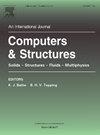基于图卷积网络的结构模态形状分类在汽车中的应用
IF 4.8
2区 工程技术
Q1 COMPUTER SCIENCE, INTERDISCIPLINARY APPLICATIONS
引用次数: 0
摘要
在工程设计周期中对结构的振型进行分类是一项劳动密集型和重复性的任务。尽管已经提出了几种自动分类模态振型的方法,但大多数现有模型不能同时使用结构和模态信息来完全表示模态振型,限制了它们在特定结构中的应用。本文提出了一种图卷积网络(GCN)模型,该模型从图的角度学习对模态振型进行分类。利用有限元法的几何和模态信息生成了模态振型图。为了验证模型的性能,建立了运动型多用途车(SUV)类型的有限元模型,作为实际复杂结构的代表。进行了定量和定性评估,以强调将模态振型表示为图形数据的优势。在开发的数据集中,分类结果表明,GCN模型在不同的几何配置和不同的输入条件下达到100 %的精度,优于现有的方法,如模态保证标准(MAC)和传统的机器学习(ML)技术。本文章由计算机程序翻译,如有差异,请以英文原文为准。
Structure mode shapes classification using graph convolutional networks in automotive application
Classifying vibration mode shapes of a structure in an engineering design cycle can be a labor intensive and repetitive task. Although several methods have been proposed to automatically classify mode shapes, most existing models cannot fully represent mode shapes using both structural and modal information, limiting their application to specific structures. In this paper, we propose a graph convolutional network (GCN) model, which learns to classify mode shapes from a graph perspective. The mode shape graphs were generated using both geometric and modal information derived from the Finite Element Method (FEM). In order to validate the model’s performance, Finite Element (FE) models of Sport Utility Vehicle (SUV) types were developed as representatives of the real-world complex structures. Both quantitative and qualitative assessments are performed to emphasise the advantages of representing mode shapes as graph data. Within the developed dataset, the classification results show that GCN models achieve 100 % precision across diverse geometric configurations and varying input conditions, outperforming existing methods such as Modal Assurance Criteria (MAC) and traditional Machine Learning (ML) techniques.
求助全文
通过发布文献求助,成功后即可免费获取论文全文。
去求助
来源期刊

Computers & Structures
工程技术-工程:土木
CiteScore
8.80
自引率
6.40%
发文量
122
审稿时长
33 days
期刊介绍:
Computers & Structures publishes advances in the development and use of computational methods for the solution of problems in engineering and the sciences. The range of appropriate contributions is wide, and includes papers on establishing appropriate mathematical models and their numerical solution in all areas of mechanics. The journal also includes articles that present a substantial review of a field in the topics of the journal.
 求助内容:
求助内容: 应助结果提醒方式:
应助结果提醒方式:


